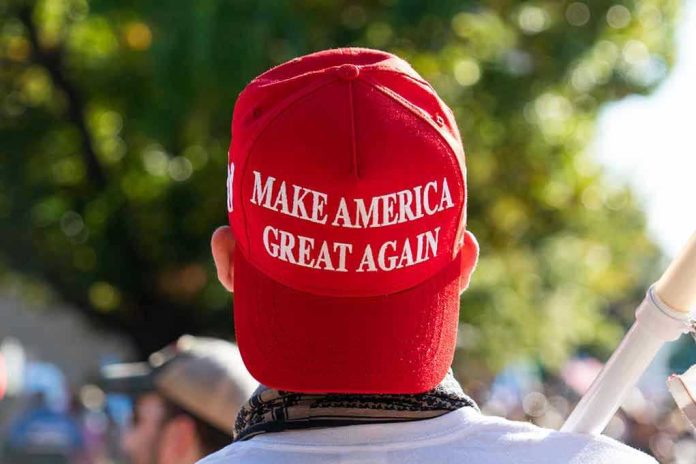
Donald Trump’s display of “Trump 2028” hats during a government shutdown negotiation meeting is a bold move that combines political theater with constitutional questions, leaving many wondering about his true intentions.
Story Highlights
- Trump placed “Trump 2028” hats during a critical Oval Office meeting.
- House Minority Leader Hakeem Jeffries described the incident as “strange.”
- The hats raise constitutional questions about a third presidential term.
- The event has sparked discussions on Trump’s political strategies and intentions.
The Provocative Display
During a pivotal meeting intended to resolve a looming government shutdown, Donald Trump introduced an unexpected element: “Trump 2028” hats. These hats, placed conspicuously on his desk, served as a provocative gesture, hinting at a potential third-term candidacy. This move, described by Hakeem Jeffries as “the strangest thing ever,” not only disrupted the meeting’s focus but also reignited debates about Trump’s long-term political ambitions.
The timing of this display was particularly significant, given the high-stakes nature of the government shutdown negotiations. With Democratic leaders like Jeffries and Chuck Schumer present, the hats seemed to serve as a deliberate distraction, shifting attention from pressing policy discussions to Trump’s audacious political messaging.
Constitutional Implications
The appearance of “Trump 2028” hats during such a crucial meeting raises pressing questions about constitutional boundaries. The 22nd Amendment clearly prohibits any individual from being elected to the presidency more than twice. However, Trump’s repeated references to a third term, both through public statements and merchandise, suggest a willingness to challenge or circumvent constitutional norms.
This incident underscores the ongoing tension between Trump’s political theatrics and the legal framework established to prevent extended presidential tenures. Constitutional scholars may find themselves debating the implications of such gestures and the potential need for legal reinforcement of these presidential term limits.
Political Theater and Strategy
The strategic placement of the hats can be seen as part of Trump’s larger approach to political communication. By blending humor with audacity, he manages to keep himself at the center of political discourse. This tactic serves to energize his base, who often view his provocations as a challenge to the political status quo.
Trump taunts Dems with ‘Trump 2028’ hats during failed government shutdown negotiations https://t.co/Pmc9wq7pbp
— Facts To Laugh At (@factstolaughat) October 1, 2025
Yet, this strategy is not without its risks. By focusing on political theater, Trump risks alienating moderates and further polarizing the political landscape. For Democratic leaders, the incident provides fodder to criticize Trump’s approach to governance and question his respect for constitutional norms.
Long-term Ramifications
The implications of Trump’s actions extend beyond immediate political theater. By continuously challenging established norms, he sets a precedent that future leaders might follow, potentially eroding the constitutional boundaries designed to ensure a balanced democratic process. The repeated references to a third term, whether serious or satirical, could normalize the idea of extending presidential tenures.
This incident also impacts the 2028 electoral landscape, particularly for Republicans. Figures like JD Vance, who was present at the meeting, might find themselves navigating a complex political terrain where Trump’s influence remains potent and unpredictable. For Democrats, this presents an opportunity to reinforce their commitment to constitutional adherence and democratic principles.







